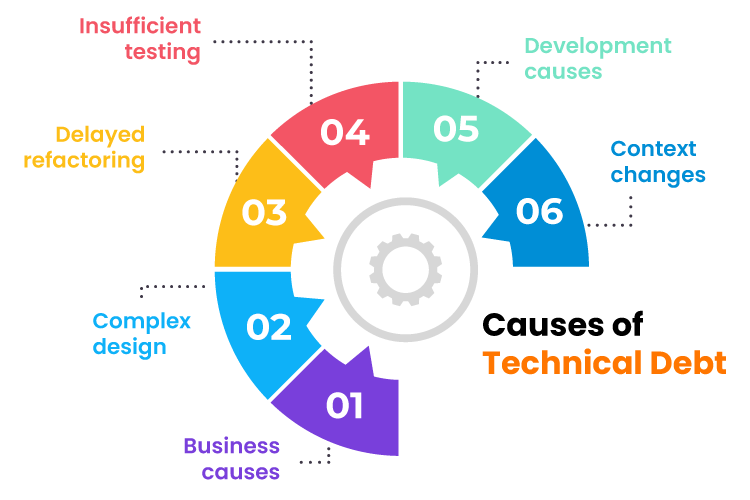
Imagine building a house without a solid foundation. Over time, cracks may appear, the structure may weaken, and repairs become increasingly costly. In the world of software development, technical debt is a similar concept. It’s the accumulation of shortcuts and suboptimal solutions that can compromise the quality, performance, and maintainability of your software.
In this blog post, we’ll delve into the nature of technical debt, its causes, and the potential consequences. We’ll also explore effective strategies to manage and pay off this debt, ensuring the long-term health and success of your software projects.
What is Tech Debt?
Tech Debt is a metaphor used to describe the consequences of choosing a quick, easy solution to a problem that will need to be addressed later. In software development, this often means taking shortcuts in the code to meet a deadline or to simplify a complex problem.
Think of it like financial debt. If you take out a loan, you’ll have to pay it back with interest over time. Similarly, techdebt accumulates interest in the form of:
- Increased development time: As the codebase becomes more complex and harder to understand, it takes longer to make changes and add new features.
- Higher maintenance costs: Bug fixes and updates become more difficult and time-consuming.
- Reduced system reliability: The risk of system failures and security vulnerabilities increases.
Why does it happen?
- Time pressures: Deadlines can force developers to prioritize speed over quality.
- Lack of knowledge or skill: Developers may not have the expertise to implement the best solution.
- Business priorities: Short-term business goals may take precedence over long-term techhealth.
How to manage technical debt:
- Identify the debt: Regularly assess your codebase to identify areas of technical debt.
- Prioritize the debt: Not all technical debt is created equal. Prioritize the most critical issues that impact system performance, security, or maintainability.
- Plan for repayment: Create a plan to address the tech debt, allocating time and resources for refactoring and improvement.
- Avoid accumulating new debt: Implement practices like code reviews, testing, and continuous integration to prevent the accumulation of new tech debt.
By understanding and managing technical debt, development teams can ensure the long-term health and sustainability of their software projects. Sources and related content
Also Read : Reducing Technical Debt for Growth & CX Excellence
Assumptions about Technical Debt
Is tech debt bad? Well, not ALWAYS. It just has a bad reputation.
It depends on what is the most important thing at a given point. Sometimes the most important thing is to bring the product directly out to the customers, and the time could be the difference between success or an epic failure.
We can reduce the negative impact of tech debt by spending time and energy on parts of the code that need agility and compromising on the parts that don’t.
As long as it is planned and not accidental, it should be fine.
Also Read: Unleashing the potential of your existing IT systems
Why is Technical Debt a barrier to Digital Innovation?
Technical debt, the accumulation of suboptimal design choices or quick fixes, can significantly hinder digital impact. Here’s how:
1. Slows Down Innovation:
- Reduced Agility: Techdebt makes it difficult to introduce new features or adapt to changing market conditions.
- Increased Development Time: Developers spend more time fixing bugs and maintaining legacy code, leaving less time for innovation.
2. Compromises Quality and Reliability:
- System Instability: Poorly designed or hastily implemented code can lead to system crashes, errors, and security vulnerabilities.
- Reduced User Experience: Technical debt can manifest in slow performance, frequent outages, and a subpar user experience.
3. Increases Costs:
- Higher Maintenance Costs: More resources are needed to maintain and support systems with technical debt.
- Delayed Time-to-Market: Tech debt can delay the launch of new products and services, resulting in lost revenue and market opportunities.
4. Hinders Digital Transformation:
- Legacy Systems: Tech debt often ties organizations to outdated systems that are incompatible with modern technologies and digital transformation initiatives.
- Data Silos: Poorly integrated systems can create data silos, hindering data-driven decision-making and analytics.
5. Impacts Employee Morale and Retention:
- Frustration and Burnout: Developers working with a technically debt-ridden codebase can experience frustration and burnout.
- Increased Turnover: High levels of technical debt can lead to increased employee turnover as talented developers seek more challenging and rewarding opportunities.
To mitigate these challenges, organizations must proactively manage tech debt by:
- Prioritizing Refactoring: Regularly invest in refactoring code to improve its quality, maintainability, and performance.
- Encouraging Best Practices: Foster a culture of code quality and adherence to best practices.
- Leveraging Modern Tools and Technologies: Utilize tools that can help automate testing, code analysis, and other tasks to reduce technical debt.
- Continuous Improvement: Regularly assess and prioritize tech debt, and allocate resources for its reduction.
By addressing technical debt, organizations can unlock the full potential of digital transformation and achieve their strategic goals.
Causes of technical debt

1. Business causes
Sometimes, the business needs to override creating the best possible code. In this case, the developers face pressure to release products faster, or there might be a need to cut the development cost.
2. Complex design
Sometimes, technical debt occurs naturally. Over time you will need to upgrade your code. But if the new developers aren’t aware or don’t take the time to understand the original design of the code, it results in technical debt.
3. Delayed refactoring
When deliberate technical debt occurs, sufficient planning must be done to tackle the debt before the interest becomes even higher. If it isn’t done, the delay can further affect the performance of your product.
4. Insufficient testing
Testing must be done before the product reaches the customers, and any bugs that arise need to be fixed. The testing team might figure out specific problems that need to be specified here. If it isn’t done satisfactorily, your customers will have to deal with the faulty code.
5. Development causes
Every code has an initial design, which needs to be appropriately documented so any work on it can be done smoothly. Lack of proper documentation, lack of skilled developers, and other resource constraints might lead to technical debt.
6. Context changes
The code will not remain perfect for long; the requirements change over time. The systems may get outdated, and updates become necessary and inevitable.
Also Read: No-Code for Enterprises: How to crack every level?
Identifying Technical Debt: A Practical Guide
Identifying technical debt is crucial to proactively address it and maintain a healthy codebase. Here are some effective methods:
Code Reviews and Static Analysis Tools
- Manual Reviews:
- Code reviews by experienced developers can identify potential issues like poor coding practices, inconsistencies, or areas of complexity.
- Look for code smells, such as duplicated code, overly complex functions, or magic numbers.
- Static Analysis Tools:
- Tools like SonarQube, Checkstyle, and PMD can automatically analyze code for potential issues, including:
- Code complexity
- Security vulnerabilities
- Code duplication
- Poor coding practices
- Potential performance bottlenecks
- Tools like SonarQube, Checkstyle, and PMD can automatically analyze code for potential issues, including:
Monitoring Development Metrics
- Code Churn: Track changes to code over time to identify areas with frequent modifications, which may indicate technical debt.
- Build Time: Monitor build times and look for increasing trends, which may signal growing complexity.
- Test Coverage: Assess the percentage of code covered by tests. Low test coverage can indicate areas of technical debt, as untested code is more prone to errors.
Gathering Feedback from Developers
- Developer Surveys: Conduct surveys to gather feedback from developers about the challenges they face in maintaining and extending the codebase.
- One-on-One Meetings: Have regular one-on-one meetings with developers to discuss their concerns and identify potential areas of technical debt.
Analyzing Incident Reports and Bug Tracking
- Frequent Issues: Identify areas of the code that frequently cause issues or bugs.
- Root Cause Analysis: Investigate the root causes of incidents to determine if they are related to technical debt.
Measuring Technical Debt Ratio
- Calculate the Cost of Remediation: Estimate the cost of fixing technical debt, including development time, testing, and deployment.
- Compare to Development Costs: Compare the cost of remediation to the ongoing cost of maintaining the current codebase.
Remember:
- Early Detection: The earlier you identify technical debt, the easier and less costly it is to address.
- Prioritization: Not all technical debt is created equal. Prioritize the most critical issues that impact system performance, security, or maintainability.
- Continuous Monitoring: Technical debt is an ongoing issue. Regular monitoring and analysis are essential to keep it under control.
- Strategic Planning: Develop a long-term plan for addressing technical debt, balancing immediate needs with long-term goals.
By implementing these strategies, you can effectively identify and manage technical debt, ensuring the long-term health and sustainability of your software projects.
Types of technical debt
All debt is not equal, and when making strategic decisions, you must know what tech debt you can live with and what you have to avoid.
Deliberate technical debt
Sometimes developers know the right way to develop a code, and they also see the time that will take, and they decide not to do that. Instead, they take the quick route to get the code to the customer faster. Thus, they make a deliberate move to incur technical debt to deliver the product quickly. This is called Deliberate technical debt. All stakeholders need to be informed of this, and steps should be taken to address and keep this from becoming a bigger debt.
It might turn into accidental design debt if it is left to accumulate.
Accidental debt
This debt is not deliberate; it occurs as time moves on. Your code might work for you now, but a year from now, you might notice that your design isn’t working anymore, and implementing something new might become harder and slower. In this case, it is essential to go back and refractor, and it will help to future-proof your designs so that this might be a little easier.
Bit rot
This is the type of technical debt you need to avoid. It happens when many people who might not know the original design work on a code. Over time the code gets complicated because it has been through many incremental changes.
You can avoid this by ensuring that every time someone needs to change or build a code, they take the time to understand the design before proceeding. Any bad code that exists needs to be cleaned up along the way so the system can be coherent and easy to upgrade.

Technical Debt Examples: The Consequences of Our Decisions
Technical debt, often likened to financial debt, occurs when developers make short-term trade-offs to accelerate development, sacrificing long-term maintainability. Here are common examples of technical debt and their consequences:
Common Examples of Technical Debt
- Insufficient Testing:
- Consequence: Increased bug rate, delayed releases, and higher maintenance costs.
- Poor Code Quality:
- Consequence: Difficulty in understanding, maintaining, and extending code, leading to longer development cycles and increased error rates.
- Lack of Documentation:
- Consequence: Steep learning curve for new developers, increased onboarding time, and potential knowledge loss.
- Outdated Technologies:
- Consequence: Security vulnerabilities, performance issues, and difficulty in hiring skilled developers.
- Tightly Coupled Components:
- Consequence: Changes in one part of the system can have unintended consequences in other parts, making it harder to make modifications.
- Hardcoded Values:
- Consequence: Difficulty in configuration and maintenance, especially for different environments.
- Suboptimal Design:
- Consequence: Scalability issues, performance bottlenecks, and increased complexity.
- Neglecting Refactoring:
- Consequence: Accumulated technical debt, making the codebase harder to understand and maintain.
Marty Cagan of Silicon Valley Product Group has stressed the critical need for organizations to dedicate at least 20% of engineering effort to addressing technical debt.
The Consequences of Technical Debt
- Increased Development Time: As the codebase becomes more complex, it takes longer to implement new features and fix bugs.
- Higher Maintenance Costs: More resources are needed to maintain and support systems with technical debt.
- Reduced Innovation: A bloated and poorly maintained codebase can hinder innovation and make it difficult to experiment with new ideas.
- Increased Risk of Security Vulnerabilities: Outdated technologies and poor coding practices can leave systems vulnerable to attacks.
- Poor User Experience: Technical debt can manifest in slow performance, frequent outages, and a subpar user experience.
- Difficulty in Hiring and Retaining Talent: Developers may be hesitant to work on projects with significant technical debt.
How to Manage Technical Debt?
As much as technical debt gives you a benefit now, It’s the deal you are making, and much like the devil, it always comes to collect. So how do you tackle the debt you already have and not let it drag your productivity to hell?
There are two ways to tackle/manage tech debt.
- Keep your new projects from adding on to the tech debt.
- Reduce the incurred debt in previous projects
To handle or manage technical debt, the trick is to strike the right balance between the time you spend, the quality you deliver, and the cost you incur. You need to pick the right debt to pay off now, the debt that you can live with, and what you never want as a debt in the first place.
The way products are being developed has been consistently changing. Organizations are looking to empower their employees, and they are looking to nurture citizen developers. At the same time, bringing products to market quickly has never been more critical. Both these scenarios increase the chances of technical debt, making it crucial for companies to develop a strategy to deal with tech debt.
Practices to Tackle Technical Debt
Some of the other best practices that you can implement now so you can breathe a bit freely tomorrow are M+M+F= Manage+ Minimize+ Fight
1. General Measures to Manage Tech Debt
- Keep a consistent record of debt as and when it is created
- Hire high-quality developers and ensure they learn the design before making any changes to the code. Also, ensure code refactoring is done regularly so there is no accumulation
- Use automated testing for your code
- Record all changes that you make
- Create a tech debt team so that the technical debt can constantly be kept in check and doesn’t get ignored
2. Agile practices to Minimize Technical Debt
Agile methodologies might come in handy while dealing with technical debt. It focuses on the continued development of a project. Iterations of the work are consistently done, so any technical debt is promptly addressed and doesn’t pile up, leading to a bigger payoff later.
It gives IT teams the ability to monitor and work on technical debts in short bursts of work. This will go a long way in reducing it in the long run.
3. No-Code to Fight Technical Debt
If you want to make your life even easier, you can go in for no-code app development. This will ensure that the coding is at its best. On top of that, it drastically cuts down the time your developers take to code, freeing them up for any other work that might be accumulated. And most importantly, no-code platforms give anyone the freedom to develop apps, so there will be no miscommunication about what is expected from the IT team.
Strategies for Addressing Technical Debt in a Digital-First Environment
In a digital-first environment, addressing tech debt is crucial for organizations to maintain agility and drive innovation. Organizations can employ several strategies to effectively manage technical debt. Firstly, they need to prioritize and assess the extent of tech debt within their systems and applications. Once identified, a comprehensive plan should be established to address the debt systematically, setting clear goals and timelines. Refactoring and modernizing legacy systems, implementing continuous integration and deployment, and promoting regular code reviews and refactoring are essential steps. Investing in developer training and skills enhancement ensures teams can write clean, maintainable code.
Striking a balance between debt reduction and innovation is important, allocating resources for both. Collaboration between development and operations teams, monitoring and measuring technical debt, and adopting agile and DevOps practices further contribute to effective debt management. By implementing these strategies, organizations can reduce tech debt, improve system performance, and thrive in the digital-first landscape.
Managing tech debt is crucial to maintaining the health and sustainability of digital systems. Here are some effective strategies for addressing tech debt:
1. Prioritize Debt Reduction
Identify and prioritize areas of tech debt based on their impact on system performance, security, and maintainability. Allocate resources and time specifically for addressing high-priority technical debt items.
2. Incremental Refactoring
Break down large technical debt issues into smaller, more manageable tasks. Implement incremental refactoring efforts to gradually improve code quality and system architecture without disrupting ongoing development work.
3. Automated Code Analysis
Utilize automated code analysis tools to identify areas of code that contribute to technical debt. These tools can help pinpoint code smells, performance bottlenecks, and security vulnerabilities, allowing teams to address them proactively.
4. Continuous Integration and Deployment (CI/CD)
Implement CI/CD pipelines to automate the build, testing, and deployment processes. By integrating automated testing and deployment procedures into the development workflow, teams can catch and address technical debt early in the development cycle.
5. Low-Code and No-Code Solutions
Leverage low-code and no-code tech to rapidly develop and deploy applications with minimal manual coding. These platforms enable citizen developers and business users to contribute to application development, reducing the reliance on custom code and potentially lowering technical debt.
6. Technical Debt Backlog
Maintain a dedicated backlog for tracking and managing technical debt items. Regularly review and prioritize items in the backlog to ensure that technical debt is actively managed and addressed alongside new feature development.
7. Cross-Functional Collaboration
Foster collaboration between development teams, operations teams, and other stakeholders to collectively address technical debt. Encourage open communication and knowledge sharing to ensure that technical debt is understood and addressed holistically.
8. Invest in Training and Education
Invest in ongoing training and education for development teams to keep them up-to-date on best practices, emerging technologies, and industry standards. Empowering team members with the necessary skills and knowledge can help prevent the accumulation of technical debt.
9. Documentation and Knowledge Sharing
Maintain comprehensive documentation and promote knowledge sharing within the team. Documenting architectural decisions, design patterns, and lessons learned can help prevent the recurrence of technical debt and facilitate smoother collaboration across team members.
10. Regular Code Reviews
Conduct regular code reviews to identify and address potential sources of technical debt. Encourage peer review practices to promote code quality, consistency, and adherence to coding standards.
11. Strategic Planning and Governance
Implement strategic planning and governance processes to manage technical debt at the organizational level. Establish clear guidelines, policies, and decision-making frameworks to ensure that technical debt is addressed systematically and in alignment with business objectives.
Revolutionize Your Development Process with Quixy’s No-Code Low-Code and Minimize Technical Debt
No-code and low-code platforms like Quixy can significantly help minimize technical debt in several ways:
1. Faster Development and Reduced Time-to-Market:
- Rapid Application Development: No-code and low-code platforms enable rapid application development, reducing the time it takes to build and deploy applications. This minimizes the need for quick fixes and shortcuts, often leading to technical debt.
- Reduced Development Time: By eliminating the need for extensive coding, these platforms reduce development time and effort. This allows developers to focus on critical features and avoid taking shortcuts to meet deadlines.
2. Improved Code Quality and Maintainability:
- Pre-built Components and Templates: No-code and low-code platforms provide pre-built components and templates that adhere to best practices, ensuring code quality and consistency.
- Visual Development: The visual development approach of these platforms makes it easier to understand and maintain applications, reducing the risk of technical debt accumulation.
- Automated Testing: Many platforms like Quixy offer built-in testing capabilities, helping to identify and fix issues early in the development process.
3. Reduced Complexity and Lower Maintenance Costs:
- Simplified Development Process: No-code and low-code platforms simplify the development process, reducing the complexity of applications and making them easier to maintain.
- Lower Maintenance Costs: By using standardized components and automated processes, these platforms help reduce maintenance costs and effort.
4. Increased Collaboration and Knowledge Sharing:
- Citizen Development: No-code and low-code platforms empower citizen developers to build applications, increasing collaboration and knowledge sharing within organizations.
- Reduced Reliance on Technical Experts: By democratizing development, these platforms reduce the reliance on technical experts, making it easier to maintain and update applications.
5. Reduced Risk of Security Vulnerabilities:
- Built-in Security Features: Many platforms have built-in security features, such as data encryption and access controls, helping to reduce the risk of security vulnerabilities.
- Regular Security Updates: Platform providers often release regular security updates, ensuring that applications built on their platforms are protected from the latest threats.
By leveraging the power of no-code and low-code platforms, organizations can significantly reduce technical debt and build more robust, scalable, and maintainable applications.
Specific Strategies to Reduce Technical Debt with Quixy
- Prioritize Refactoring: Identify areas of your existing applications that could benefit from a Quixy makeover. Refactor these areas to improve their maintainability and reduce technical debt.
- Modernize Legacy Systems: Gradually replace outdated legacy systems with modern, Quixy-powered applications. This can help reduce the maintenance burden and improve overall system performance.
- Automate Processes: Automate repetitive tasks and workflows using Quixy’s automation capabilities. This can reduce the risk of human error and improve efficiency.
- Foster a Culture of Continuous Improvement: Encourage a culture of continuous improvement within your organization. Regularly review your applications and identify opportunities to reduce technical debt.
By leveraging Quixy’s capabilities, organizations can significantly reduce technical debt and build more robust, scalable, and maintainable applications.
Conclusion
Technology is inherently dynamic, necessitating constant code evolution. This means that technical debt, the accumulation of suboptimal design choices or quick fixes, is an unavoidable part of software development. The key lies in understanding its context: strategic decisions and informed trade-offs can turn technical debt into a tactical advantage, accelerating development without compromising long-term maintainability. However, excessive or unchecked debt can significantly hinder productivity.
To mitigate this risk, organizations can leverage no-code and low-code platforms like Quixy. By streamlining development processes and reducing the need for extensive coding, these platforms help build robust, scalable, and maintainable applications, effectively minimizing technical debt.
Frequently Asked Questions(FAQs)
Q. What causes tech debt?
Technical debt can arise due to time constraints, rushed development, changing requirements, poor coding practices, or neglecting proper documentation or testing.
Q. How do you manage tech debt?
Managing tech debt involves acknowledging its existence, prioritizing areas to address, allocating resources for refactoring or improvements, and fostering a culture of clean code and continuous improvement.
Q. How can you pay off tech debt?
Paying off technical debt involves investing time and resources into refactoring code, addressing outdated or inefficient components, improving documentation, and dedicating efforts to resolve underlying issues.
Q. What are the benefits of addressing tech debt?
Addressing technical debt leads to enhanced system stability, increased development speed in the long term, reduced maintenance costs, improved code quality, and better adaptability to future changes or enhancements.
Q. Is it possible to completely eliminate tech debt?
Complete elimination of technical debt might be unattainable as software systems evolve and change over time. However, teams can significantly reduce and manage technical debt to maintain a healthy codebase with proactive management, consistent improvement practices, and a focus on quality.
Subscribe
Login
Please login to comment
0 Comments
Oldest
















